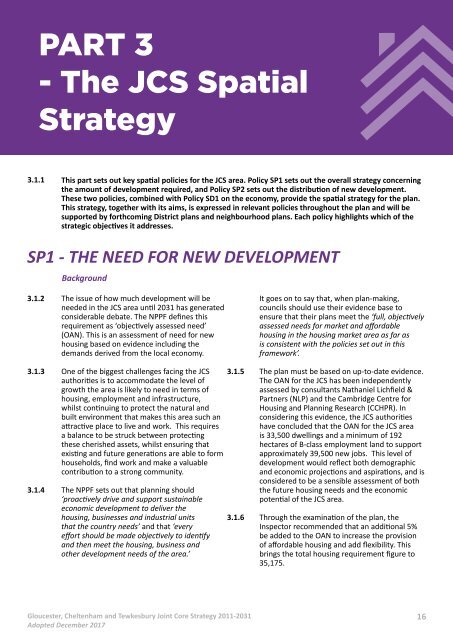JCS_MasterDocument_FIN_27.03.18
Create successful ePaper yourself
Turn your PDF publications into a flip-book with our unique Google optimized e-Paper software.
PART 3<br />
- The <strong>JCS</strong> Spatial<br />
Strategy<br />
3.1.1 This part sets out key spatial policies for the <strong>JCS</strong> area. Policy SP1 sets out the overall strategy concerning<br />
the amount of development required, and Policy SP2 sets out the distribution of new development.<br />
These two policies, combined with Policy SD1 on the economy, provide the spatial strategy for the plan.<br />
This strategy, together with its aims, is expressed in relevant policies throughout the plan and will be<br />
supported by forthcoming District plans and neighbourhood plans. Each policy highlights which of the<br />
strategic objectives it addresses.<br />
SP1 - THE NEED FOR NEW DEVELOPMENT<br />
Background<br />
3.1.2<br />
3.1.3<br />
3.1.4<br />
The issue of how much development will be<br />
needed in the <strong>JCS</strong> area until 2031 has generated<br />
considerable debate. The NPPF defines this<br />
requirement as ‘objectively assessed need’<br />
(OAN). This is an assessment of need for new<br />
housing based on evidence including the<br />
demands derived from the local economy.<br />
One of the biggest challenges facing the <strong>JCS</strong><br />
authorities is to accommodate the level of<br />
growth the area is likely to need in terms of<br />
housing, employment and infrastructure,<br />
whilst continuing to protect the natural and<br />
built environment that makes this area such an<br />
attractive place to live and work. This requires<br />
a balance to be struck between protecting<br />
these cherished assets, whilst ensuring that<br />
existing and future generations are able to form<br />
households, find work and make a valuable<br />
contribution to a strong community.<br />
The NPPF sets out that planning should<br />
‘proactively drive and support sustainable<br />
economic development to deliver the<br />
housing, businesses and industrial units<br />
that the country needs’ and that ‘every<br />
effort should be made objectively to identify<br />
and then meet the housing, business and<br />
other development needs of the area.’<br />
3.1.5<br />
3.1.6<br />
It goes on to say that, when plan-making,<br />
councils should use their evidence base to<br />
ensure that their plans meet the ‘full, objectively<br />
assessed needs for market and affordable<br />
housing in the housing market area as far as<br />
is consistent with the policies set out in this<br />
framework’.<br />
The plan must be based on up-to-date evidence.<br />
The OAN for the <strong>JCS</strong> has been independently<br />
assessed by consultants Nathaniel Lichfield &<br />
Partners (NLP) and the Cambridge Centre for<br />
Housing and Planning Research (CCHPR). In<br />
considering this evidence, the <strong>JCS</strong> authorities<br />
have concluded that the OAN for the <strong>JCS</strong> area<br />
is 33,500 dwellings and a minimum of 192<br />
hectares of B-class employment land to support<br />
approximately 39,500 new jobs. This level of<br />
development would reflect both demographic<br />
and economic projections and aspirations, and is<br />
considered to be a sensible assessment of both<br />
the future housing needs and the economic<br />
potential of the <strong>JCS</strong> area.<br />
Through the examination of the plan, the<br />
Inspector recommended that an additional 5%<br />
be added to the OAN to increase the provision<br />
of affordable housing and add flexibility. This<br />
brings the total housing requirement figure to<br />
35,175.<br />
Gloucester, Cheltenham and Tewkesbury Joint Core Strategy 2011-2031<br />
Adopted December 2017<br />
16




